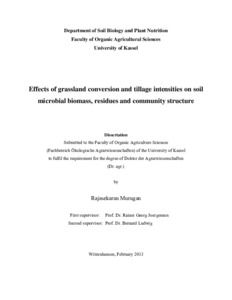| dc.date.accessioned | 2013-09-23T12:53:57Z | |
| dc.date.available | 2013-09-23T12:53:57Z | |
| dc.date.issued | 2013-09-23 | |
| dc.identifier.uri | urn:nbn:de:hebis:34-2013092343966 | |
| dc.identifier.uri | http://hdl.handle.net/123456789/2013092343966 | |
| dc.description.sponsorship | I am indebted to the Deutsche Forschungsgemeinschaft for funding the Research Training Group (DFG 1397 “Regulation of soil organic matter and nutrient turnover in organic agriculture”). | ger |
| dc.language.iso | eng | |
| dc.rights | Urheberrechtlich geschützt | |
| dc.rights.uri | https://rightsstatements.org/page/InC/1.0/ | |
| dc.subject | Grassland | eng |
| dc.subject | Tillage | eng |
| dc.subject | Microbial biomass | eng |
| dc.subject | Microbial residues | eng |
| dc.subject | Microbial community structure | eng |
| dc.subject | Slurry application | eng |
| dc.subject.ddc | 630 | |
| dc.title | Effects of grassland conversion and tillage intensities on soil microbial biomass, residues and community structure | eng |
| dc.type | Dissertation | |
| dcterms.abstract | Agricultural intensification has a strong impact on level of soil organic matter (SOM), microbial biomass stocks and microbial community structure in agro-ecosystems. The size of the microbial necromass C pool could be about 40 times that of the living microbial biomass C pool in soils. Due to the specificity, amino sugar analysis gives more important information on the relative contribution of fungal and bacterial residues to C sequestration potential of soils. Meanwhile, the relationship between microbial biomass and microbial necromass in soil and its ecological significance on SOM are not fully understood and likely to be very complex in grassland soils. This thesis focuses on the effects of tillage, grassland conversion intensities and fertilisation on microbial biomass, residues and community structure.
The combined analyses of microbial biomass and residue formation of both fungi and bacteria provided a unique opportunity to study the effect of tillage, grassland conversion and fertilisation on soil microbial dynamics. In top soil at 0-30 cm layer, a reduction in tillage intensity by the GRT and NT treatments increased the accumulation of saprotrophic fungi in comparison with the MBT treatment. In contrast, the GRT and NT treatments promoted AMF at the expense of saprotrophic fungi in the bottom soil layer at 30-40 cm depth. The negative relationship between the ergosterol to microbial biomass C ratio and the fungal C to bacterial C ratio points to the importance of the relationship between saprotrophic fungi and biotrophic AMF for tillage-induced changes in microbial turnover of SOC.
One-season cultivation of winter wheat with two tillage events led to a significant loss in SOC and microbial biomass C stocks at 0-40 cm depth in comparison with the permanent grassland, even 5 years after the tillage event. However, the tillage induced loss in microbial biomass C was roughly 40% less in the long-term than in the short-term of the current experiment, indicating a recovery process during grassland restoration. In general, mould board tillage and grassland conversion to maize monoculture promoted saprotrophic fungi at the expense of biotrophic AMF and bacteria compared to undisturbed grassland soils. Slurry application promoted bacterial residues as indicated by the decreases in both, the ergosterol to microbial biomass C ratio and the fungal C to bacterial C ratio. In addition, the lost microbial functional diversity due to tillage and maize monoculture was restored by slurry application both in arable and grassland soils.
I conclude that the microbial biomass C/S ratio can be used as an additional indicator for a shift in microbial community. The strong relationships between microbial biomass and necromass indices points to the importance of saprotrophic fungi and biotrophic AMF for agricultural management induced effects on microbial turnover and ecosystem C storage. Quantitative information on exact biomass estimates of these two important fungal groups in soil is inevitably necessary to understand their different roles in SOM dynamics. | eng |
| dcterms.accessRights | open access | |
| dcterms.creator | Murugan, Rajasekaran | |
| dc.contributor.corporatename | Kassel, Universität, FB 11, Ökologische Agrarwissenschaften | |
| dc.contributor.referee | Joergensen, Rainer Georg (Prof. Dr.) | |
| dc.contributor.referee | Ludwig, Bernard (Prof. Dr.) | |
| dc.subject.swd | Grünland | ger |
| dc.subject.swd | Ackerbau | ger |
| dc.subject.swd | Bodenbearbeitung | ger |
| dc.subject.swd | Düngemittel | ger |
| dc.subject.swd | Bodenmikroorganismus | ger |
| dc.date.examination | 2013-04-22 | |

